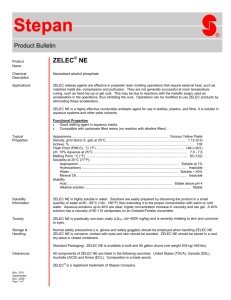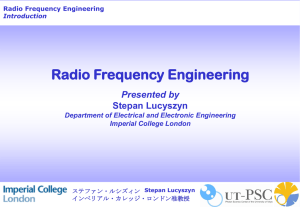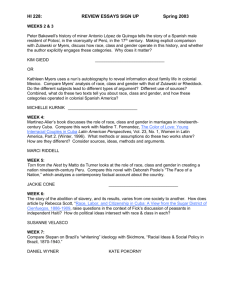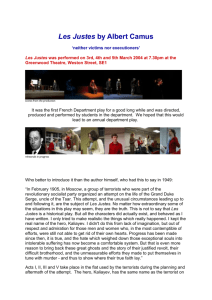Radio Frequency Engineering Lecture #6 Engineering
advertisement
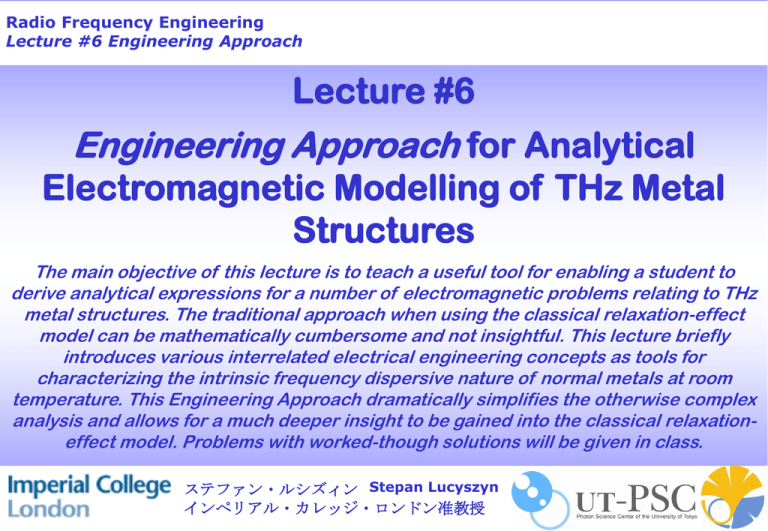
Radio Frequency Engineering
Lecture #6 Engineering Approach
Lecture #6
Engineering Approach for Analytical
Electromagnetic Modelling of THz Metal
Structures
The main objective of this lecture is to teach a useful tool for enabling a student to
derive analytical expressions for a number of electromagnetic problems relating to THz
metal structures. The traditional approach when using the classical relaxation-effect
model can be mathematically cumbersome and not insightful. This lecture briefly
introduces various interrelated electrical engineering concepts as tools for
characterizing the intrinsic frequency dispersive nature of normal metals at room
temperature. This Engineering Approach dramatically simplifies the otherwise complex
analysis and allows for a much deeper insight to be gained into the classical relaxationeffect model. Problems with worked-though solutions will be given in class.
ステファン・ルシズィン Stepan Lucyszyn
インペリアル・カレッジ・ロンドン准教授
Radio Frequency Engineering
Lecture #6 Engineering Approach
OVERVIEW
Drude’s frequency dispersion model
The Engineering Approach
Equivalent transmission line model
Q-factor for metals
Kinetic inductance
Complex skin depth
Boundary resistance coefficient
Applications
Metal-pipe rectangular waveguides
Cavity resonators
Single metal planar shield
Conclusions
ステファン・ルシズィン Stepan Lucyszyn
インペリアル・カレッジ・ロンドン准教授
Radio Frequency Engineering
Lecture #6 Engineering Approach
Drude’s Model
Classical relaxation-effect frequency dispersion model:
o
o
'
Simple Relaxation Effect Model
R
2
R R ' j R ' '
1 ( )
1 j
o
Classical Skin Effect Model
ステファン・ルシズィン Stepan Lucyszyn
インペリアル・カレッジ・ロンドン准教授
Radio Frequency Engineering
Lecture #6 Engineering Approach
#1 Line Modelling
Electromagnetic Characterisation of Homogenous Materials
I
j
j
o r ' ' j o r '
' o r ' ' j ' ' o r '
j
I
j j
[ ]
o r ' ' j o r ' ' o r ' ' j ' ' o r '
[m 1 ]
Compare vector Helmholtz equations (for an unbounded plane wave
in one-dimensional space) with those of the telegrapher's equations.
ステファン・ルシズィン Stepan Lucyszyn
インペリアル・カレッジ・ロンドン准教授
Radio Frequency Engineering
Lecture #6 Engineering Approach
Generic Equivalent Transmission Line Model
Free space
o
Normal material at room temperature
o
R
o
o
L
L
R
G
C
Dz << l
ステファン・ルシズィン Stepan Lucyszyn
インペリアル・カレッジ・ロンドン准教授
G
C
Zo
Radio Frequency Engineering
Lecture #6 Engineering Approach
Intrinsic Modelling for Normal Metals at Room Temperature
Generic equations:
Z S R S jX S
j 0 r
j o
j 0 r
S S j S
ZS
j 0 r
j o r
with 10 15 rad / s
and S
1
1
S S
ステファン・ルシズィン Stepan Lucyszyn
インペリアル・カレッジ・ロンドン准教授
and c c ' j c ' '
1
S
Radio Frequency Engineering
Lecture #6 Engineering Approach
Classical skin-effect model:
Normal metal at room temperature
o
Io
jo
o
o
1 j []
2 o
Z So ( RSo jX So ) [ / square ]
o
o
Dz << lo
ステファン・ルシズィン Stepan Lucyszyn
インペリアル・カレッジ・ロンドン准教授
LSo
o
RSo
Radio Frequency Engineering
Lecture #6 Engineering Approach
Classical relaxation-effect model:
RR jLR
ZoR
GR jC R
ZoR IR
RSR
RR jLR
R
ZoR
j o
o
o
j
2
2
1
1
RR jLR GR jC R
Z SR ( RSR jX SR )
RSo
Z SR RSo
Z SR
1
LSR
1
u 4 u 2 u 1 u 1
ステファン・ルシズィン Stepan Lucyszyn
インペリアル・カレッジ・ロンドン准教授
u
Radio Frequency Engineering
Lecture #6 Engineering Approach
Classical relaxation-effect models:
Normal metal at room temperature
o
o
o
2
1
o
2
1
o
2
1
LSR
o
2
1
RSR
Dz<< lR
o
o
2
1
o
1
2 o Dz 2
2
o
2
1
LSR {Z SR } /
1
2 o Dz 2
2
Dz<< lR
ステファン・ルシズィン Stepan Lucyszyn
インペリアル・カレッジ・ロンドン准教授
RSR {ZSR}
Radio Frequency Engineering
Lecture #6 Engineering Approach
Distributed-element parameters for the
classical relaxation-effect model
RR 0 ;
LR o
o
; GR
2
1
; CR
o
1
2
Distributive shunt inductance
1
1
2
C R Dz 2 2 o Dz 2
2
LSHUNT _ R
ステファン・ルシズィン Stepan Lucyszyn
インペリアル・カレッジ・ロンドン准教授
[ H / m]
o
o
1
2
Radio Frequency Engineering
Lecture #6 Engineering Approach
Propagation Delay Per Unit Wavelength
pR
l
v pR
lR
v pR
1
f
s / lR
R jLR (GR jCR )
2
where lR
; v pR
{ R }
{ R }
1
jLR GR j
2
LSHUNT _ R Dz
ステファン・ルシズィン Stepan Lucyszyn
インペリアル・カレッジ・ロンドン准教授
j R
Radio Frequency Engineering
Lecture #6 Engineering Approach
Circuit-based Simulation Results for Gold at Room Temperature
with = 1, depth l = lR, Dz = lR / 400 = 1.067 [nm]
Elementary Lumped-element Circuit Values
Equivalent
Transmission
Line model
ZIN []
(Theory:
0.4608+j1.1124)
ZT = ZSR
pR
[fs/lR]
(Theory:
170:494)
RRDz
[]
LRDz
[fH]
GRDz
[mS]
CRDz
[fF]
LSHUNT_RDz
[pH]
Extracted
model
1.341
24.1
-0.654
0.4607 + j1.137
170.491
Alternative
Extracted
model
1.341
24.1
1.126
0.4607 + j1.137
170.491
ステファン・ルシズィン Stepan Lucyszyn
インペリアル・カレッジ・ロンドン准教授
Radio Frequency Engineering
Lecture #6 Engineering Approach
#2 Kinetic Inductance
LSR LSo Lk LSo 1 [ H / square]
Kinetic inductance is created from the inertial mass of a mobile charge
carrier distribution within an alternating electric field (i.e. classical
electrodynamics).
1 / 2
So
1 / 2
L
and
LSo
k
o So
2
LSo Lk
RSR
LSR
a 0.539
and
X SR
LSR Lk
LSo
for 0 2
ステファン・ルシズィン Stepan Lucyszyn
インペリアル・カレッジ・ロンドン准教授
Surface Resistance, Ohms/square
Radio Frequency Engineering
Lecture #6 Engineering Approach
2.5
Classical skin-effect RSo
Simple relaxation-effect RSR '
Classical relaxation-effect RSR
2.0
Gold at room
temperature
1.5
1.0
0.5
0.0
0
2
4
6
8
10
12
Frequency, THz
ステファン・ルシズィン Stepan Lucyszyn
インペリアル・カレッジ・ロンドン准教授
Intrinsic classical
skin-effect model
overestimates
ohmic losses and
Detuning. Also,
underestimates
extrinsic losses.
Radio Frequency Engineering
Lecture #6 Engineering Approach
Surface Reactance, Ohms/square
2.5
Classical skin-effect XSo
Simple relaxation-effect XSR '
Classical relaxation-effect XSR
2.0
Gold at room
temperature
1.5
Intrinsic classical
skin-effect model
underestimates
perturbation
detuning
1.0
0.5
0.0
0
2
4
6
8
10
12
Frequency, THz
ステファン・ルシズィン Stepan Lucyszyn
インペリアル・カレッジ・ロンドン准教授
10
10
Surface Inductances, [pH/square]
Surface Reactances, [Ohms/square]
Radio Frequency Engineering
Lecture #6 Engineering Approach
0
f = 5.865 THz
-1
a = 0.539
10
-2
LSO
LSK
LSR
10
-1
10
-2
2.5x10
a = 0.539
f = 5.865 THz
LSO= (oo) / 2
LSK= RSo
LSR= XSR /
-3
(LSO+ a LSK)
10
LSO+ a LSK
-3
0
1
2
3
4
5
6
7
8
9
10
11
12
0
1
2
Frequency, THz
ステファン・ルシズィン Stepan Lucyszyn
インペリアル・カレッジ・ロンドン准教授
3
4
5
6
7
8
Frequency, THz
9
10
11
12
Radio Frequency Engineering
Lecture #6 Engineering Approach
#3 Q-factor
Material Q-Factor
r effective
1
Qm
tan
r effective
equivalent Z S 2
0
n2
2
Qm
2
n2
2
equivalent
ZS
0
ステファン・ルシズィン Stepan Lucyszyn
インペリアル・カレッジ・ロンドン准教授
for Qmo
for QmR
Radio Frequency Engineering
Lecture #6 Engineering Approach
Qc
Component Q-Factor
Xc
Rc
1
n Z S
Qc
n Z S
1
1 Qc
Qm
2Qc
2
and
Qc Qm 1 Qm
for Qco
for QcR
2
Classical relaxation-effect model:
QmR ( )
QcR 1 QmR 2
ステファン・ルシズィン Stepan Lucyszyn
インペリアル・カレッジ・ロンドン准教授
Radio Frequency Engineering
Lecture #6 Engineering Approach
4.5
Qc
4.0
Qm
3.5
Gold at room
temperature
Q-Factors
3.0
f = 5.865 THz
2.5
2.0
QcR
1.5
Qco
1.0
QmR
0.5
Qmo
0.0
0
2
4
6
8
Frequency, THz
ステファン・ルシズィン Stepan Lucyszyn
インペリアル・カレッジ・ロンドン准教授
10
12
Radio Frequency Engineering
Lecture #6 Engineering Approach
Complex Skin Depth: c
#4 Complex Skin Depth
1
c ' j c ' ' [m]
ステファン・ルシズィン Stepan Lucyszyn
インペリアル・カレッジ・ロンドン准教授
Qc
c
c
Radio Frequency Engineering
Lecture #6 Engineering Approach
Classical relaxation-effect model:
1
{ cR }QcR j
cR { co } QcR j
Q
cR
c. f .
Z SR
1
{Z So }
j QcR {Z SR }1 jQcR
Q
cR
ステファン・ルシズィン Stepan Lucyszyn
インペリアル・カレッジ・ロンドン准教授
Radio Frequency Engineering
Lecture #6 Engineering Approach
90
SO
80
SR
Im{ CO }
70
Im{ CR }
Re{ CR }
Gold at room
temperature
Lengths, nm
60
l o/10
l R/10
50
40
30
20
1 / 3
10
0
1
2
3
4
5
6
7
8
Frequency, THz
ステファン・ルシズィン Stepan Lucyszyn
インペリアル・カレッジ・ロンドン准教授
9
10
11
12
Radio Frequency Engineering
Lecture #6 Engineering Approach
#5 Resistance Coefficient
Boundary resistance coefficient:
k o
Rs
Surface dissipative power density per unit area:
Po
PS
Po = Power flux density per unit area in air
k
Forward E-field and average power tilt angle:
tan 1 k
For a cube in any mode (with perturbation theory only):
2
1
QU TE
k ~ 0.74 k
6
mnl
ステファン・ルシズィン Stepan Lucyszyn
インペリアル・カレッジ・ロンドン准教授
Radio Frequency Engineering
Lecture #6 Engineering Approach
Line Model Validation
A B cosh( l ) Zo sinh( l )
[ ABCD ]
C
D
Yo
sinh(
l
)
cosh(
l
)
o
o
2
1
o
1
2 o Dz 2
2
o
2
1
LSR {Z SR } /
1
2 o Dz 2
2
Dz<< lR
Elementary Lumped-element Circuit
ステファン・ルシズィン Stepan Lucyszyn
インペリアル・カレッジ・ロンドン准教授
RSR {ZSR}
Radio Frequency Engineering
Lecture #6 Engineering Approach
When the terminating impedance is equal to the complex conjugate
of the characteristic impedance of the transmission line:
ステファン・ルシズィン Stepan Lucyszyn
インペリアル・カレッジ・ロンドン准教授
Radio Frequency Engineering
Lecture #6 Engineering Approach
Gold at room
temperature
ステファン・ルシズィン Stepan Lucyszyn
インペリアル・カレッジ・ロンドン准教授
Radio Frequency Engineering
Lecture #6 Engineering Approach
Comparison of modelled parameters for gold at room temperature, at 5.865 THz, determined from
theory, direct ABCD parameter matrix calculations and synthesized equivalent transmission line
models using commercial circuit simulation software
Parameters for
Synthesized Transmission Line
Theory
ABCD Parameter
Microwave Office®
l = lR , = 1, ZT = Z*SR
Matrix Calculations
No. of Sections, N
--400
800
400
800
ZSR[]
0.46079043
0.46079964
0.46079043
----+j1.11244650
+j1.11246875
+j1.11244650
RlR[lR-1]
15.1689
15.1681
15.1685
----+j6.2832
-j0.0013
-j0.0004
S11
0
0.0006
0.0002
0.0006
0.0001
+j0.0271
+j0.0135
+j0.0270
+j0.0133
Return Loss [dB]
-247.51
-31.35
-37.41
-31.37
-36.9
S11= e-2(1+2)
2.583
2.579
2.582
2.564
2.567
7
[1+j(1+2)]10
+j6.237
+j6.242
+j6.240
+j6.238
+j6.239
GMAX [dB]
-123.4126
-123.4093
-123.4099
-123.41
-123.4
Absorption Loss [dB]
-131.756
-131.748
-131.752
-131.9
-131.9
S11= tan-1(1+2)[o]
67.50
67.55
67.52
67.58
67.56
ステファン・ルシズィン Stepan Lucyszyn
インペリアル・カレッジ・ロンドン准教授
Radio Frequency Engineering
Lecture #6 Engineering Approach
THz MPRWGs
y
lg _ ideal
b
d
x
z
W G TE
a
10
lo
lo
1
lc
Rs ( )
o
2
lo
fc
1
f
G10 ( ) [ Np / m]
2
j o r
Zs( )
j o
[ / square ]
and
b c TE1 0
1 2
a
G10 ( )
2
c TE
10
b 1
ステファン・ルシズィン Stepan Lucyszyn
インペリアル・カレッジ・ロンドン准教授
2
[m 1 ]
Radio Frequency Engineering
Lecture #6 Engineering Approach
New Waveguide Standard for Terahertz Frequencies
Why New Standard ?
• No extension of industry standards
above 325 GHz (WR-3)
• No compatibility among hardware
• Impractical transitions
• Defined in inches, rounding errors
1.5 THz Frequency Multiplier
Chain (JPL)
John Ward, JPL 2006
ステファン・ルシズィン Stepan Lucyszyn
インペリアル・カレッジ・ロンドン准教授
5 THz horns and
coupler (C. Walker
U. Arizona)
Radio Frequency Engineering
Lecture #6 Engineering Approach
New Waveguide Standard for Terahertz Frequencies:
ISO 497 Preferred Metric Sizes
•
•
•
•
•
Widely used global industry standard
Logarithmic scale
Infinitely extendable
Repeats every decade
Decision tree with range
of coarse and fine spacing
ステファン・ルシズィン Stepan Lucyszyn
インペリアル・カレッジ・ロンドン准教授
Radio Frequency Engineering
Lecture #6 Engineering Approach
Proposed air-filled MPRWG and
cavity resonator definitions and specifications
ステファン・ルシズィン Stepan Lucyszyn
インペリアル・カレッジ・ロンドン准教授
Radio Frequency Engineering
Lecture #6 Engineering Approach
Variational Methods for Calculating
Propagation Constant for the TEmo Mode
ステファン・ルシズィン Stepan Lucyszyn
インペリアル・カレッジ・ロンドン准教授
Radio Frequency Engineering
Lecture #6 Engineering Approach
Calculated attenuation constants for the dominant TE10 mode
8
Classical skin-effect o
Classical skin-effect o
Simple relaxation-effect R '
0.5
Attenuation Constant, dB/mm
Attenuation Constant, dB/mm
0.6
Classical relaxation-effect R
0.4
0.3
100 m
0.2
125 m
160 m
0.1
0.0
0.8
200 m
25 m
Classical relaxation-effect R '
7
Classical relaxation-effect R
6
5
32 m
4
3
50 m
2
75 m
1
0
1.0
1.2
1.4
1.6
1.8
2.0
2.2
2.4
2.6
2.8
3.0
2
3
4
Frequency, THz
ステファン・ルシズィン Stepan Lucyszyn
インペリアル・カレッジ・ロンドン准教授
5
6
7
8
Frequency, THz
9
10
11
12
Radio Frequency Engineering
Lecture #6 Engineering Approach
Resulting errors in attenuation constant calculations
Power Loss Method (for simplicity)
Error in Attenuation Constant, %
400
Classical skin-effect
Simple relaxation-effect
350
c d
2
b f c
c
1 2
2
a
f
f c
b 0 1
f
2
R' R
1
100%
E R '
1 100%
2
1
R
Rs
300
250
200
150
Classical skin-effect: 108% error at 12 THz
100
50
0
0
1
2
3
4
5
6
7
Frequency, THz
8
9
10
11
12
R
E o o
R
100 %
2
1 1 100%
Simple relaxation-effect: 373% at 12 THz
ステファン・ルシズィン Stepan Lucyszyn
インペリアル・カレッジ・ロンドン准教授
Radio Frequency Engineering
Lecture #6 Engineering Approach
Errors in attenuation constant
Classical skin-effect: 108% error at 12 THz
W GR
100%
Eo W Go
W GR
RSo RSR
Eo
RSR
E o
2
1 1 100%
1
j 1
100% with Z SR RSo
1
QcR 1 100% QmR 100%
E o 0.539 QmR 100%
for 0 2
e.g. Calculated error using this approximation is 110% at 12 THz
ステファン・ルシズィン Stepan Lucyszyn
インペリアル・カレッジ・ロンドン准教授
Radio Frequency Engineering
Lecture #6 Engineering Approach
HFSSTM electromagnetic simulations of attenuation constant
for JPL 100 m band
0.60
0.60
Calculated classical skin-effect o
Simple relaxation-effect R '
0.55
Attenuation Constant, dB/mm
Attenuation Constant, dB/mm
Classical skin-effect o
Classical relaxation-effect R
Effective relaxation-effect using R' & R'
0.50
0.45
0.40
0.35
0.30
0.25
1.8
1.9
2.0
2.1
2.2
2.3
2.4
2.5
2.6
2.7
2.8
2.9
Calculated simple relaxation-effect R '
0.55
Calculated classical relaxation-effect R
Classical skin-effect in HFSS
0.50
All relaxation-effect in HFSS
TM
TM
0.45
0.40
0.35
0.30
0.25
1.8
1.9
2.0
Frequency, THz
ステファン・ルシズィン Stepan Lucyszyn
インペリアル・カレッジ・ロンドン准教授
2.1
2.2
2.3
2.4
2.5
Frequency, THz
2.6
2.7
2.8
2.9
Radio Frequency Engineering
Lecture #6 Engineering Approach
THz Cavity Resonators
With Perturbation model, unloaded Q-factor in the mnl mode :
I _ mnl
QU 'o TE
mnl where mnl o mnl [H ]
R S 'o
mn l
Geometric factor : mnl
QU 'o TE
mnl
2ba d
[ m]
3
3
2
2
2ba d ad a d
lI _ mnl
8
2
2 3/ 2
b a d
k 'o
2 2b a 3 d 3 ad a 2 d 2
For a cube, QU 'o TE
mnl
2 3/ 2
2
o
1 / 2
'
,
where
k
'
o
o
R S 'o
2
k 'o ~ 0.74 k 'o For all modes!
6
ステファン・ルシズィン Stepan Lucyszyn
インペリアル・カレッジ・ロンドン准教授
Radio Frequency Engineering
Lecture #6 Engineering Approach
lI _ mnl
c
f I _ mnl
I _ mnl
c m
n
l
2 a
2
b
d
2
f I _ mnl
2
2
2 a for half height i.e. d a 2b
lI _101
2
2
a d
8 / 3 a most common d 2 a 2 2 b
2ad
Volume/Area for d a
a / 6 for cube i.e. d a b
abd (a 2 d 2 )
101
a / 8 for half height i.e. d a 2b
3
3
2
2
2[2b(a d ) ad (a d )]
3 a /[ 2( 2 10)] most common i.e. d 2 a 2 2 b
ステファン・ルシズィン Stepan Lucyszyn
インペリアル・カレッジ・ロンドン准教授
Radio Frequency Engineering
Lecture #6 Engineering Approach
Complex Resonant Frequency
As determined by Eigenmode solution in HFSSTM
2
o
1
j
~o o ' jo ' ' o 1
2Qu o
2Qu o
~o ~ o j
o
with perturbati on model
2Qu o
Do ' (I o ' )
Overall frequency detuning
DI (I o )
takes into account both perturbation
(represented by Xs) and detuning due to Ohmic losses (represented by Rs)
0
Due to RS 0 Due to X S 0
o '
Do '
o
DI
I
ステファン・ルシズィン Stepan Lucyszyn
インペリアル・カレッジ・ロンドン准教授
Radio Frequency Engineering
Lecture #6 Engineering Approach
Over-simplified Solution
(O. Klein et al.,1993, and M. Dressel & G. Gruner, 2002)
I
~ ~ j I
Q
R
I
U
I
o
I
S
I
2Qu I
RS I
Simplified Solution
(J. C. Salter, 1946)
~ ~ ( D ) j
o
I
I
I
2Qu I
where DI is due to perturbation
ステファン・ルシズィン Stepan Lucyszyn
インペリアル・カレッジ・ロンドン准教授
Radio Frequency Engineering
Lecture #6 Engineering Approach
Cavity Perturbation Formula
Change in Surface Impedance:
Exact Solution
I
o
QU o
Self-consistent
analytical solution for
all dispersion models
Self-consistent
analytical solution
With r 1 and
2
1
o
~
j
o o ' jo ' ' o 1
2Qu o
2Qu o
0
o '
Using Im c o instead of S
E
ステファン・ルシズィン Stepan Lucyszyn
インペリアル・カレッジ・ロンドン准教授
RS o '
QU o '
EQ
Radio Frequency Engineering
Lecture #6 Engineering Approach
Derivation of Driven Frequency of Oscillation
After equalizing equations for surface reactance:
o oR
oR 1 (oR ) 2 oR
I oR
8o o
where K
r
o oR'
o oo
K 0
3a
for most common i.e. d 2 a 2 2 b
2( 2 10)
oR' 1 (oR' ) 2
K 0
I oR'
oo
K 0
I oo
oo W I W I I
2
ステファン・ルシズィン Stepan Lucyszyn
インペリアル・カレッジ・ロンドン准教授
2
where W
1
2K 2
Radio Frequency Engineering
Lecture #6 Engineering Approach
Self-consistent Solution for General Case of Metal
3
2
2 2
I
lI ( I )
2b a d
Qu o
8 r c o o 2b a 3 d 3 ad a 2 d 2
I 3 2a
1
for most common i.e. d 2 a 2 2 b
Qu o
r c o o 4 5 2 1
ステファン・ルシズィン Stepan Lucyszyn
インペリアル・カレッジ・ロンドン准教授
Radio Frequency Engineering
Lecture #6 Engineering Approach
30
700
Classical skin-effect
Simple relaxation-effect
Classical relaxation-effect
650
200 m
600
550
25
Classical skin-effect in HFSS
TM
160m
20
500
125m
450
15
400
100 m
350
75 m
300
10
250
5
200
50 m
32 m
150
25 m
100
0
1
2
3
4
5
Frequency, THz
ステファン・ルシズィン Stepan Lucyszyn
インペリアル・カレッジ・ロンドン准教授
6
7
0
8
Frequency Detuning, GHz
Gold at room
temperature
Unloaded Q-factor for TE101 Cavity Mode
750
Radio Frequency Engineering
Lecture #6 Engineering Approach
80
45
25 m
70
40
Gold at room
temperature
Error in Q Factor, %
32m
35
60
30
50
50m
25
40
75 m
20
100 m
125 m
160 m
30
20
15
10
200 m
10
5
0
0
0
1
2
3
4
5
Frequency, THz
ステファン・ルシズィン Stepan Lucyszyn
インペリアル・カレッジ・ロンドン准教授
6
7
8
Error in Frequency Detuning, %
Classical skin-effect
Simple relaxation-effect
Radio Frequency Engineering
Lecture #6 Engineering Approach
Q Uo 'oo TE
QUR 'oR TE
I _ mnl
mnl
r So 'oo 'oo
2
mnl
mnl
I _ mnl
mnl
r cR 'oR 'oR
1
QUo 'oo TE
QUR 'oR TE
ステファン・ルシズィン Stepan Lucyszyn
インペリアル・カレッジ・ロンドン准教授
mnl
mnl
QUo 1 TE
QmR 'oo
QUo 1 TE
mnl
mnl
QcR 'oR
QmR 'oR
Radio Frequency Engineering
Lecture #6 Engineering Approach
Errors in Unloaded Q-factor
Classical skin-effect: 41% error at 7.3 THz
EQo 'oR
EQo 'oR
QUo ( 'oo ) QUR ( 'oR )
100%
QUR ( 'oR )
1
QcR 'oR
1 100%
1
100%
EQo 'oR
1
1 1.8553 QmR 'oR
QmR 'oR
1 100%
QmR 'oo QcR 'oR
'oR 'oo
0 2
e.g. Calculated error using this approximation is 40% at 7.3 THz
ステファン・ルシズィン Stepan Lucyszyn
インペリアル・カレッジ・ロンドン准教授
Radio Frequency Engineering
Lecture #6 Engineering Approach
• HFSSTM current versions (v.10 & 11) cannot accurately predict
the performance of structures operating at terahertz frequencies
• Intrinsic dispersion models: Classical skin-effect & simple
relaxation-effect inflate the attenuation. Therefore, extrinsic loss
effects (e.g. surface roughness) may be underestimated
ステファン・ルシズィン Stepan Lucyszyn
インペリアル・カレッジ・ロンドン准教授
Radio Frequency Engineering
Lecture #6 Engineering Approach
THz Metal Shielding
RF metal shielding is found in many applications; ranging from:
• Construction of high isolation subsystem partitioning walls
• Efficient quasi-optical components (e.g. planar mirrors and parabolic
reflectors for open resonators and antennas)
• Creating guided-wave structures that have (near-)zero field leakage
(e.g. metal-pipe rectangular waveguides and associated closed cavity
resonators)
• Embedding ground planes within compact 3D multi-layer architectures.
ステファン・ルシズィン Stepan Lucyszyn
インペリアル・カレッジ・ロンドン准教授
Radio Frequency Engineering
Lecture #6 Engineering Approach
Metal shields should be made as thin as possible, while meeting the minimum
values for figures of merit within the intended bandwidth of operation, in order to
reduce weight and cost.
For reasons of structural integrity, thin metal shielding can be deposited onto either
a solid plastic/ceramic or even honeycomb supporting wall.
Thin metal shielding embedded between dielectric layers (e.g. to create conformal
ground planes or partition walls) can avoid issues of poor topography when integrating
signal lines within 3D multi-layered architectures.
Shielding effectiveness, return loss and absorptance (or absorptivity) are important
figures of merit that are quoted to quantify the ability to shield electromagnetic
radiation.
An electrical engineering approach, which can include network analysis and the
synthesis of predictive equivalent transmission line models, can accurately solve
specific EM problems.
ステファン・ルシズィン Stepan Lucyszyn
インペリアル・カレッジ・ロンドン准教授
Radio Frequency Engineering
Lecture #6 Engineering Approach
Uniform plane wave at normal incidence to
an infinite single planar shield in air
Physical representation
Equivalent 2-port network model
Z S ZT
Voltage-wave reflection coefficients: 1 Z Z
S
T
ZT Z S
2
1
Z S ZT
2ZT
2Z S
2 1 2
1
1
1
Voltage transmission coefficients:
Z S ZT
Z S ZT
ステファン・ルシズィン Stepan Lucyszyn
インペリアル・カレッジ・ロンドン准教授
Radio Frequency Engineering
Lecture #6 Engineering Approach
S-Parameters Analysis for Single Planar Shield
Transient response solution
S 21
T T
1 e
e 2
i 0
2i
2i
2 T
T
S11 1 1 e
2 e 2 2
2
i 0
i [0, 1, 2..]
Steady-state solution
S 21
e T
1
T
1 e 1
2
2
1 e 2 T
S11 1
1 e T 1
e T 1 1
ステファン・ルシズィン Stepan Lucyszyn
インペリアル・カレッジ・ロンドン准教授
2
Radio Frequency Engineering
Lecture #6 Engineering Approach
S-Parameters Analysis for Single Planar Shield
Boundary resistance coefficient
1
1 k
1 k
jQc
1
jQc
1
k
o
RS
Qc 1
21 jQc
21 jQc 21 jQc
1 k jQc k jQc
k
2
2k
2k
2
1 k jQc k jQc
a = thickness normalized to normal skin depth
j
T a S a 1
Qc
Therefore, R 5 SR 5
e.g.
Q cR( 1) (1
and
T aR SR
R
j
[5 SR 1 ]
5 1
{ R }QcR
QcR
2)
R ( 1) 5 SR ( 1) 5 1
ステファン・ルシズィン Stepan Lucyszyn
インペリアル・カレッジ・ロンドン准教授
j
1
2
[5 SR ]
1
Radio Frequency Engineering
Lecture #6 Engineering Approach
S-Parameters Analysis: Classical Relaxation-effect Model
S 21R
4k R 1 jQcR e
j
aR 1
QcR
1 k R jQcR 1 k R jQcR
2
2
e
j
2 aR 1
QcR
2 1 jQcR
j
k R sinh a R 1
QcR
Approximation error : < 0.4% up to aR = 10, frequency less than 12 THz
S11R
j
j
2 aR 1
sinh a R 1
Q
1 e cR
QcR
1 R
2
j
1 k R jQcR
j
aR 1 QcR
sinh a R 1
ln
1
e
1R
1 k R jQcR
QcR
ステファン・ルシズィン Stepan Lucyszyn
インペリアル・カレッジ・ロンドン准教授
Radio Frequency Engineering
Lecture #6 Engineering Approach
S-Parameters Analysis: Classical Skin-effect Model
T
ao
S21o
So
4 2 j ko e a o
2
2 j ko
aR SR
So
2j
2
2 j ko e 2 a o
2j
2 2j
ko sinh ao 2 j
Approximation error : < 0.6% up to aR = 10, frequency less than 12 THz
S11o
1 e 2 ao 2 j
1o
1 e ao 2 j
1o
sinh ao 2 j
2
sinh a 2 j ln 2 j k o
o
2 j k
o
ステファン・ルシズィン Stepan Lucyszyn
インペリアル・カレッジ・ロンドン准教授
Radio Frequency Engineering
Lecture #6 Engineering Approach
Analysis of Shielding Effectiveness (SE)
Pt
SEdB 10 log 10 [dB]
Pi
SEdB 20 log 10 S 21R e j oT 20 log 10 S 21R RdB AdB M dB
Cross-boundary reflections
RdB 20 log 10 1R 2 R 20 log 10
Absorption
Z SR o 2
4Z SR o
~ 20 log 10
o
kR
20 log 10
4Z SR
4 1 jQcR
AdB 20 log 10 e R T 20 log 10 eT / S R 20 log 10 e a R 8.686 aR
Multiple reflections
M dB 20 log
10
1 e
R T
1R
2
~ 20 log
10
1 e
2 R T
ステファン・ルシズィン Stepan Lucyszyn
インペリアル・カレッジ・ロンドン准教授
20 log
10
1 e
j
2 aR 1
QcR
Radio Frequency Engineering
Lecture #6 Engineering Approach
Correction Factor for Multiple Reflections Calculations
M dB 20 log 10 1 e
R T
1R
2
Classical-relaxation Model
EMdB
M dB _ approximation M dB _ exact
M dB _ exact
100%
Error using Approximation
ステファン・ルシズィン Stepan Lucyszyn
インペリアル・カレッジ・ロンドン准教授
Radio Frequency Engineering
Lecture #6 Engineering Approach
Screening Effectiveness Calculations
Classical Relaxation-effect Model
2
8 1 QcR
/ kR2
SEdBR 10 log 10
cosh( 2aR ) cos(2aR / QcR )
Classical Skin-effect Model
16 / ko2
SEdBo 10 log 10
cosh( 2ao ) cos( 2ao )
Less shielding as
frequency increases and/or
thickness decrease
ステファン・ルシズィン Stepan Lucyszyn
インペリアル・カレッジ・ロンドン准教授
Radio Frequency Engineering
Lecture #6 Engineering Approach
).
Screening Effectiveness Calculations-Error using Approximation
ESE dB
SEdBo SEdBR
100%
SEdBR
Due to absorption, a peak value
7.8% at aR = 10 1 / 3
Beyond the peak region
Linearly increase,
11.7% at T = lm = 1.6SR
2.046
ステファン・ルシズィン Stepan Lucyszyn
インペリアル・カレッジ・ロンドン准教授
Radio Frequency Engineering
Lecture #6 Engineering Approach
Reflection Characteristics: Return Loss Calculations
P
RLdB 10 log 10 r 10 log 10 20 log 10 S11 [dB]
Pi
2
S11R
for all aR
RL R
kR 2
2
for aR 3
1R
kR 2
Less reflected power as
frequency increases and/or
thickness decrease
ステファン・ルシズィン Stepan Lucyszyn
インペリアル・カレッジ・ロンドン准教授
Radio Frequency Engineering
Lecture #6 Engineering Approach
Reflection Characteristics: Return Loss Calculations
Error using Classical Skin-effect
ERL dB
RLdBo RLdBR
100%
RLdBR
109% at T = 10SR
2.046
Thickness invariant above
aR 3
ステファン・ルシズィン Stepan Lucyszyn
インペリアル・カレッジ・ロンドン准教授
Radio Frequency Engineering
Lecture #6 Engineering Approach
Absorptance Calculations
Pt
Pa
ABdB 10 log 10 10 log 10 1
Pi
Pi
10 log 10 1 SE RL
Pr
Pi
1 S21R 2 S11R 2 for all aR
AB
4
2
1 1R k RSR for aR 3
R
More absorbed power as
frequency increases and/or
thickness decrease
ステファン・ルシズィン Stepan Lucyszyn
インペリアル・カレッジ・ロンドン准教授
Radio Frequency Engineering
Lecture #6 Engineering Approach
Absorptance Calculations: Error using Classical Skin-effect
E ABdB
ABdBo ABdBR
100%
ABdBR
14% at T = 10SR
2.046
Thickness invariant above
aR 3
ステファン・ルシズィン Stepan Lucyszyn
インペリアル・カレッジ・ロンドン准教授
Radio Frequency Engineering
Lecture #6 Engineering Approach
Synthesis Modelling of Metal Shielding Walls
Classical Relaxation-effect Model: Equivalent transmission line model
o
o
o
1R
o
o
o
2
1
o
1R
2R
1
2 o Dz 2
2
N 2
o
2
1
1
2 o Dz 2
2
Dz lR
o
o
o
o
2R
For example, at 5.865 THz, gold at room temperature
LR Dz 1.341 [ fH ]
GR Dz 24.1 [mS]
LSHUNT _ R Dz 1.126 [ pH ]
ステファン・ルシズィン Stepan Lucyszyn
インペリアル・カレッジ・ロンドン准教授
Radio Frequency Engineering
Lecture #6 Engineering Approach
Comparison of modelled parameters for gold at room temperature, at 5.865 THz, determined from
theory, direct ABCD parameter matrix calculations and synthesized equivalent transmission line
models using commercial circuit simulation software
ステファン・ルシズィン Stepan Lucyszyn
インペリアル・カレッジ・ロンドン准教授
Radio Frequency Engineering
Lecture #6 Engineering Approach
Conclusions
•
An electrical engineering approach to the modelling of specific electromagnetic problems
at THz frequencies is introduced, using 5 interrelated concepts (transmission line
modelling, kinetic inductance, Q-factor, complex skin depth and boundary resistance
coefficient).
•
The Engineering Approach has 5 main advantages:
– Excellent pedagogical tool
– Greatly reduces otherwise lengthy mathematical derivations
– Reduces risk of introducing mistakes
– Avoids the need for poor approximations
– Can replace the need for slow numerical computations (with simple structures)
– Gives new perspectives and deeper insight
•
While the focus has been on the characterization of normal metals (magnetic and nonmagnetic) at room temperature, it is believed that the same methodology may also be
applied to metals operating in anomalous frequency-temperature regions,
superconductors, semiconductors, carbon nanotubes and metamaterials.
ステファン・ルシズィン Stepan Lucyszyn
インペリアル・カレッジ・ロンドン准教授
